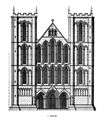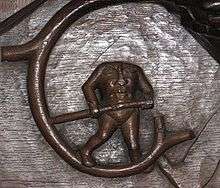Ripon Cathedral
| Ripon Cathedral | |
|---|---|
 The west end of the cathedral | |
 Ripon Cathedral Shown within North Yorkshire | |
| Coordinates: 54°8′5″N 1°31′12″W / 54.13472°N 1.52000°W | |
| Location | Ripon, North Yorkshire |
| Country | England |
| Denomination | Church of England |
| Tradition | Anglo-Catholic[1] |
| Website | www.riponcathedral.org.uk |
| Architecture | |
| Status | Cathedral (since 1836) |
| Functional status | Active |
| Heritage designation | Grade I |
| Style | Anglo-Saxon, Gothic (Early English) |
| Years built | 1160–1547 |
| Administration | |
| Diocese | Leeds (since 2014) |
| Province | York |
| Clergy | |
| Dean | John Dobson |
| Precentor | Paul Greenwell |
| Canon(s) |
Elizabeth Sewell (Canon Pastor & Canon Educator) |
| Laity | |
| Director of music | Andrew Bryden |
| Organist(s) | Tim Harper |
The Cathedral Church of St Peter and St Wilfrid, commonly known as Ripon Cathedral, is a cathedral in the North Yorkshire city of Ripon. Founded as a monastery by Scottish monks in the 660s, it was refounded as a Benedictine monastery by St Wilfrid in 672. The church became collegiate in the tenth century, and acted as a mother church within the large Diocese of York for the remainder of the Middle Ages.[2] In 1836 the church became the cathedral for the Diocese of Ripon.[3] In 2014 the Diocese was incorporated into the new Diocese of Leeds, and the church became one of three co-equal cathedrals of the Bishop of Leeds.
The cathedral is notable architecturally for its gothic west front in the Early English style, considered one of the best of its type, as well as the Geometric east window.[3] The seventh-century crypt of Wilfrid's church is a significant example of early Christian architecture in England.[3] The cathedral has Grade I listed building status.[4]
Background
There has been a stone church on the site since 672 when Saint Wilfrid replaced the previous timber church of the monastery at Ripon (a daughter house of Saint Aidan's monastery at Melrose) with one in the Roman style. This is one of the earliest stone buildings erected in the Anglo-Saxon Kingdom of Northumbria. The crypt dates from this period.
People have been coming to worship and pray at Ripon for more than 1,350 years. The cathedral building is part of this continuing act of worship, begun in the 7th century when Saint Wilfrid built one of England's first stone churches on this site, and still renewed every day. Within the nave and choir, you can see the evidence of 800 years in which master craftsmen have expressed their faith in wood and stone.
History



Today's church is the fourth to have stood on this site. Saint Wilfrid brought stonemasons, plasterers and glaziers from France and Italy to build his great basilica in AD 672. A contemporary account by Eddius Stephanus tells us:
- "In Ripon, Saint Wilfrid built and completed from the foundations to the roof a church of dressed stone, supported by various columns and side-aisles to a great height and many windows, arched vaults and a winding cloister."
Saint Wilfrid was buried in this church near the high altar. Devastated by the English king Eadred in AD 948 as a warning to the Archbishop of York, only the crypt of Wilfrid's church survived but today this tiny 7th-century chapel rests complete beneath the later grandeur of Archbishop Roger de Pont l’Evêque’s 12th century minster. A second minster soon arose at Ripon, but it too perished – this time in 1069 at the hands of William the Conqueror. Thomas of Bayeux, first Norman Archbishop of York, then instigated the construction of a third church, traces of which were incorporated into the later chapter house of Roger's minster.
The Early English west front was added in 1220, its twin towers originally crowned with wooden spires and lead. The east window was built as part of a reconstruction of the choir between 1286-8 and 1330, and was described by architecture critic Pevsner as a 'splendid' example of the series of large Decorated gothic windows constructed in Northern England. Major rebuilding had to be postponed due to the outbreak of the Wars of the Roses but resumed after the accession of Henry VII and the restoration of peace in 1485. The nave was widened and the central tower partially rebuilt. The church's thirty-five misericords were carved between 1489 and 1494. The same (Ripon) school of carvers also carved the misericords at Beverley Minster and Manchester Cathedral. But in 1547, before this work was finished, Edward VI dissolved Ripon's college of canons. All revenues were appropriated by the Crown and the tower never received its last perpendicular arches. It was not until 1604 that James I issued his Charter of Restoration.
Cathedral status

The minster finally became a cathedral (the church where the Bishop has his cathedra or throne) in 1836, the focal point of the newly created Anglican Diocese of Ripon — the first to be established since the Reformation.[5]
Dean and chapter
- Dean – John Dobson (since 14 June 2014 installation)[6]
- Sub-Dean & Canon Residentiary – Ailsa Newby (since June 2017)[7]
- Precentor – Paul Greenwell (since 18 May 2008)[8]
- Canon Pastor & Canon Educator – Elizabeth Sewell (since 31 January 2013 installation)[9]
Music


The musical tradition in the cathedral is very strong.[10] The current director of music is Andrew Bryden, with Tim Harper as Assistant Director of Music and Philippa Abrahams as Concerts Administrator.[11]
Organ
The cathedral has a fine organ by Harrison and Harrison dating from 1926. The organ is on the screen and has casework by Gilbert Scott. A specification of the organ can be found on the National Pipe Organ Register. The organ was refurbished in 2013. These works included a thorough cleaning and repair of all pipe work; selective re-leathering of reservoirs and drawstop motors; reconstruction/rationalisation of the wind distribution system; refurbishment and updating of the screen console and cleaning of the case. The only minor tonal changes during these works were the replacement of Great Larigot 1 1/3 (1972) by a Flûte harmonique 8 (in Lewis style) and the recasting of Choir Cimbel III at a lower pitch.
Organists
In 1447, the organ at Ripon Cathedral was played by a priest, Thomas Litster. Notable organists have included composers Charles Harry Moody and Ronald Edward Perrin.
Bells
A ring of 12 bells with an additional 'flat sixth' bell is hung in the south-west tower. A diatonic ring of ten bells was cast in 1932, and three additional bells were installed in 2008 with two new trebles being added to give a diatonic ring of twelve, and an additional 'flat sixth' bell to give a light ring of eight.[12]
Gallery
 The west front.
The west front.- Detail of the western façade.
%2C_Yorkshire%2C_UK_-_Diliff.jpg) A misericord, alleged inspiration for Lewis Carroll’s Alice's Adventures in Wonderland
A misericord, alleged inspiration for Lewis Carroll’s Alice's Adventures in Wonderland A blemyah carving from a choir stall.
A blemyah carving from a choir stall. Ripon Minster, by Hendrik Frans de Cort, c. 1800.
Ripon Minster, by Hendrik Frans de Cort, c. 1800. Stained glass window St. Michael, West end
Stained glass window St. Michael, West end Moses and Melchisedec, Stainde glass window St. Peter's chapel
Moses and Melchisedec, Stainde glass window St. Peter's chapel
See also
- Ripon
- Architecture of the medieval cathedrals of England
- English Gothic architecture
- Romanesque architecture
- Church of England
- Diocese of Leeds
- Dean and Chapter of Ripon
References and sources
- References
- ↑ Blagdon-Gamlen, P. E. (1973) The Church Travellers Directory. London: Church Literature Association; p. 75
- ↑ "History of the Secular and Diocesan Boundaries in Yorkshire" (PDF). Retrieved 3 May 2017.
- 1 2 3 Pevsner, Nikolaus; Metcalf, Priscilla (2005). The Cathedrals of England: The North and East Anglia. London: The Folio Society. p. 255.
- ↑ Historic England. "Ripon Minster (Cathedral Church of St Peter and Wilfrid) (1150164)". National Heritage List for England. Retrieved 16 November 2014.
- ↑ Hallett, Cecil (1901). The cathedral church of Ripon : a short history of the church & a description of its fabric. London: Bell. p. 36. OCLC 636588670.
- ↑ Archived 28 May 2014 at the Wayback Machine.
- ↑ "Canon Ailsa returns to Northern Roots | Ripon Cathedral". riponcathedral.info. 20 June 2017. Retrieved 20 June 2017.
- ↑ "Ripon Cathedral Friends – Annual Report 2008" (PDF). Friendsofriponcathedral.org.uk. Retrieved 27 October 2014.
- ↑ Archived 7 April 2013 at the Wayback Machine.
- ↑ "The Cathedral Choir". Ripon Cathedral. Retrieved 27 October 2014.
- ↑ "The Music Department". Ripon Cathedral. Retrieved 27 October 2014.
- ↑ Emma Baxter. "Yorkshire Association of Change Ringers Latest News, Accessed 29 March 2009". Yacr.org.uk. Retrieved 27 October 2014.
- Sources
- "The Dioceses Commission's Yorkshire Review – A Guide to the Report" (PDF). Churchofengland.org.
External links
| Wikimedia Commons has media related to Ripon Cathedral. |
- Ripon Cathedral Website
- Ripon Cathedral on Skyscrapernews.com
- Ripon Cathedral Library and the Dean and Chapter Archive; University of Leeds
- A history of the choristers of Ripon Cathedral
- MUSIC AT RIPON CATHEDRAL 657–2008